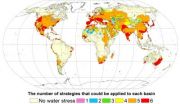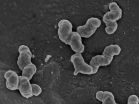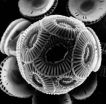(Press-News.org) Making something new is never easy. Scientists constantly theorize about new materials, but when the material is manufactured it doesn't always work as expected. To create a new strategy for designing materials, scientists at the Department of Energy's Argonne National Laboratory combined two different approaches at two different facilities to synthesize new materials.
This new strategy gives faster feedback on what growth schemes are best, thus shortening the timeframe to manufacture a new, stable material for energy transport and conversion applications.
A recent article in Nature Materials describes how researchers used X-ray scattering during a process called molecular beam epitaxy (MBE) to observe the behavior of atoms as a type of material known as layered oxides were being formed. These observations were then used as data for computational predictions of new materials, leading to insights on how to best combine atoms to form new, stable structures.
"MBE is the construction of new materials one layer at a time—and each layer is one-atom thick. We used a new type of MBE system to observe what happens during the growth of oxide thin films. We found that the layers spontaneously rearrange to reach a lower energy, preferred configuration—but not necessarily the configuration we intended," said John Freeland, the Argonne physicist who led the team. "Most scientists would not expect layers to move around like this, but this is important information to know when designing new materials."
In experimenting with a class of oxides known as strontium titanates, the research team found that when they layered titanium on top of two layers of Strontium, the titanium layer switched places with the second strontium layer, thus becoming the center layer. When titanium was layered on multiple layers of strontium, titanium always switched places with the strontium layer directly underneath it (Figures 1 and 2).
Argonne chemist June Hyuk Lee lead the experimental development of the in situ oxide MBE, and Guangfu Luo from the University of Wisconsin-Madison developed the theoretical approach to unraveling the energetics that drive the layer rearrangements.
The research team included expertise from Argonne's Advanced Photon Source (APS), Center for Nanoscale Materials (CNM), Chemical Sciences and Engineering, and Materials Science, and partners from Northwestern University, the University of Connecticut-Storrs and the University of Wisconsin-Madison, who wanted to understand the driving force behind the rearrangements. Using density functional theory (DFT) and computational resources at the CNM, they calculated and compared the energies of different layer sequences, using the data collected from the MBE system. They found that the actual layer sequences corresponded to the lowest energy configuration. Their computations also showed that layer exchange was not unique to strontium and titanium; in fact, it was expected for many different materials systems. With this understanding, scientists can control—on an atomic level—the growth of oxide thin-films.
"What we have here is a new strategy for materials design and synthesis," said Argonne materials scientist and article co-author Dillon Fong. "Our combination of in situ X-ray scattering with computational theory can be extended to other layered materials and structures, even theoretical ones that haven't been made yet because they are challenging to manufacture."
This new strategy gives faster feedback on what growth strategies are best, thus shortening the timeframe to actual manufacture of a new, stable material.
In the future, Argonne wants to make oxide MBE a tool available to APS facility users for synthesis science. "The APS was instrumental in making our findings possible," explained Freeland. "The X-rays gave us the quantitative information we needed to plug into the theoretical framework, which in turn will allow us—and other APS users--to make new materials more efficiently."
Films were grown in the in situ X-ray chamber at Sector 33ID-E of the APS. Calculations were carried out on the Fusion Cluster of Argonne's Laboratory Computing Resource Center at the National Energy Research Scientific Computing Center (NERSC) and on Argonne's Carbon Cluster.
The paper, "Dynamic layer rearrangement during growth of layered oxide films by molecular beam epitaxy," was published in Nature Materials.
INFORMATION:
This work was supported by the U.S. Department of Energy Office of Science, and partially supported by the University of Wisconsin Materials Research Science and Engineering Center.
The Advanced Photon Source at Argonne National Laboratory is one of five national synchrotron radiation light sources supported by the U.S. Department of Energy's Office of Science to carry out applied and basic research to understand, predict, and ultimately control matter and energy at the electronic, atomic, and molecular levels, provide the foundations for new energy technologies, and support DOE missions in energy, environment, and national security. To learn more about the Office of Science X-ray user facilities, visit the user facilities directory.
The Center for Nanoscale Materials at Argonne National Laboratory is one of the five DOE Nanoscale Science Research Centers (NSRCs), premier national user facilities for interdisciplinary research at the nanoscale, supported by the DOE Office of Science. Together the NSRCs comprise a suite of complementary facilities that provide researchers with state-of-the-art capabilities to fabricate, process, characterize and model nanoscale materials, and constitute the largest infrastructure investment of the National Nanotechnology Initiative. The NSRCs are located at DOE's Argonne, Brookhaven, Lawrence Berkeley, Oak Ridge and Sandia and Los Alamos National Laboratories.
Argonne National Laboratory seeks solutions to pressing national problems in science and technology. The nation's first national laboratory, Argonne conducts leading-edge basic and applied scientific research in virtually every scientific discipline. Argonne researchers work closely with researchers from hundreds of companies, universities, and federal, state and municipal agencies to help them solve their specific problems, advance America's scientific leadership and prepare the nation for a better future. With employees from more than 60 nations, Argonne is managed by UChicago Argonne, LLC for the U.S. Department of Energy's Office of Science.
DOE's Office of Science is the single largest supporter of basic research in the physical sciences in the United States, and is working to address some of the most pressing challenges of our time. For more information, please visit science.energy.gov.
Argonne scientists pioneer strategy for creating new materials
2014-08-29
ELSE PRESS RELEASES FROM THIS DATE:
Aging Africa
2014-08-29
Boulder, Colorado, USA – In the September issue of GSA Today, Paul Bierman of the University of Vermont–Burlington and colleagues present a cosmogenic view of erosion, relief generation, and the age of faulting in southernmost Africa. By measuring beryllium-10 (10Be) in river sediment samples, they show that south-central South Africa is eroding at the slow rate of about five meters per million years, consistent with rates in other non-tectonically active regions.
By measuring 10Be and aluminum-26 (26Al) in exposed quartzites, Bierman and colleagues find that undeformed ...
Preventing cancer from forming 'tentacles' stops dangerous spread
2014-08-29
EDMONTON, AB – A new study from the research group of Dr. John Lewis at the University of Alberta (Edmonton, AB) and the Lawson Health Research Institute (London, ON) has confirmed that "invadopodia" play a key role in the spread of cancer. The study, published in Cell Reports, shows preventing these tentacle-like structures from forming can stop the spread of cancer entirely.
Roughly 2 in 5 Canadians will develop cancer in their lifetime, and one in four of them will die of the disease. In 2014, it's estimated that nine Canadians will die of cancer every hour. Thanks ...
Reducing water scarcity possible by 2050
2014-08-29
Water scarcity is not a problem just for the developing world. In California, legislators are currently proposing a $7.5 billion emergency water plan to their voters; and U.S. federal officials last year warned residents of Arizona and Nevada that they could face cuts in Colorado River water deliveries in 2016.
Irrigation techniques, industrial and residential habits combined with climate change lie at the root of the problem. But despite what appears to be an insurmountable problem, according to researchers from McGill and Utrecht University it is possible to turn the ...
Evidence mounting that older adults who volunteer are happier, healthier
2014-08-29
Toronto, Canada – Older adults who stay active by volunteering are getting more out of it than just an altruistic feeling – they are receiving a health boost!
A new study, led by the Rotman Research Institute at Baycrest Health Sciences and published online this week in Psychological Bulletin, is the first to take a broad-brush look at all the available peer-reviewed evidence regarding the psychosocial health benefits of formal volunteering for older adults.
Lead investigator Dr. Nicole Anderson, together with scientists from Canadian and American academic centres, ...
NASA sees Hurricane Cristobal racing through North Atlantic
2014-08-29
Satellite imagery shows Hurricane Cristobal racing through the North Atlantic on Friday, August 29 while losing its tropical characteristics. An image from NOAA's GOES-East satellite showed Cristobal headed south of Greenland. The previous day, NASA's TRMM satellite saw heavy rainfall occurring in the hurricane.
In a visible image from NOAA's GOES-East satellite on August 29 at 7:45 a.m. EDT, Hurricane Cristobal was moving through the North Atlantic about 500 miles southwest of Greenland. The image was created by the NASA/NOAA GOES Project at NASA's Goddard Space Flight ...
CCNY team defines new biodiversity metric
2014-08-29
To understand how the repeated climatic shifts over the last 120,000 years may have influenced today's patterns of genetic diversity, a team of researchers led by City College of New York biologist Dr. Ana Carnaval developed a new biodiversity metric called "phylogeographic endemism."
It quantifies the degree to which the genetic variation within species is restricted in geographical space.
Dr. Carnaval, an assistant professor of biology, and 14 other researchers from institutions in Brazil, Australia and the United States, analyzed the effects of current and past climatic ...
Hydrogen powers important nitrogen-transforming bacteria
2014-08-29
This news release is available in German. Nitrite-oxidizing bacteria are key players in the natural nitrogen cycle on Earth and in biological wastewater treatment plants. For decades, these specialist bacteria were thought to depend on nitrite as their source of energy. An international team of scientists led by Holger Daims, a microbiologist at the University of Vienna, has now shown that nitrite-oxidizing bacteria can use hydrogen as an alternative source of energy. The oxidation of hydrogen with oxygen enables their growth independent of nitrite and a lifestyle outside ...
NASA animation shows Hurricane Marie winding down
2014-08-29
VIDEO:
This video of NOAA's GOES-West satellite imagery from Aug. 26-29 shows Hurricane Marie winding down into a post-tropical storm.
Click here for more information.
NOAA's GOES-West satellite keeps a continuous eye on the Eastern Pacific and has been covering Hurricane Marie since birth. NASA's GOES Project uses NOAA data and creates animations and did so to show the end of Hurricane Marie.
At 5 a.m. EDT (0900 UTC) on Friday, August 29, Marie became a post-tropical storm ...
'Face time' for the heart diagnoses cardiac disease
2014-08-29
To the careful observer, a person's face has long provided insight into what is going on beneath the surface. Now, with the assistance of a web camera and software algorithms, the face can also reveal whether or not an individual is experiencing atrial fibrillation, a treatable but potentially dangerous heart condition.
A pilot project, the results of which were published online today in the journal Heart Rhythm, demonstrates that subtle changes in skin color can be used to detect the uneven blood flow caused by atrial fibrillation. The technology was developed in a ...
Not all phytoplankton in the ocean need to take their vitamins
2014-08-29
Some species of marine phytoplankton, such as the prolific bloomer Emiliania huxleyi, can grow without consuming vitamin B1 (thiamine), researchers have discovered. The finding contradicts the common view that E. huxleyi and many other eukaryotic microbes depend on scarce supplies of thiamine in the ocean to survive.
"It's a really different way to think about the ocean," says CIFAR Senior Fellow Alexandra Worden, co-author on The ISME Journal paper with CIFAR fellows John Archibald (Dalhousie University), Adrián Reyes-Prieto (University of New Brunswick) and three lead ...





